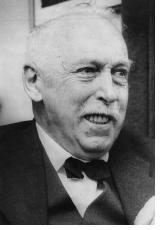Ejnar Hertzsprung
Astronomer; b. 8 October 1873 (Frederiksberg, Denmark), d. 21 October 1967 (Roskilde).
 Ejnar Hertzsprung's father had studied astronomy but had been unable to find employment in that field and had become a director of an insurance company. But Hertzsprung started his career as an engineer. He studied chemistry at the Copenhagen Polytechnics. From 1898 to 1901 he worked in St. Petersburg and took up studies in chemistry again in 1902 in Leipzig. Wen his brother died he returned to Copenhagen to live with his sister and mother. The family was wealthy, and Hertzsprung set himself up as a private scientist. He used his chemical knowledge as a hobby photographer and developed an interest in astronomy.
Ejnar Hertzsprung's father had studied astronomy but had been unable to find employment in that field and had become a director of an insurance company. But Hertzsprung started his career as an engineer. He studied chemistry at the Copenhagen Polytechnics. From 1898 to 1901 he worked in St. Petersburg and took up studies in chemistry again in 1902 in Leipzig. Wen his brother died he returned to Copenhagen to live with his sister and mother. The family was wealthy, and Hertzsprung set himself up as a private scientist. He used his chemical knowledge as a hobby photographer and developed an interest in astronomy.
In 1905 Hertzsprung published Zur Strahlung der Sterne (On the luminosity of the stars) in the Zeitschrift für Wissenschaftliche Photographie (Journal for scientific photography). In that paper he stated that the luminous red stars must be very big, that the little number of extremely large red stars now known as red giants suggests that these stars are in a stage of fast evolution, and that there must be a connection between the spectrum and the luminosity of stars.
In 1907 he published Zur Bestimmung der photographischen Sterngrössen (On the determination of photographic star sizes), in which he outlined a method to determine star distances from their spectral characteristics. He sent a preprint to Schwarzschild, the director of the Göttingen observatory, and was asked to visit the observatory. He was appointed an extraordinary professor in 1908 and followed Schwarzschild to the Potsdam observatory in the following year.
In 1910 Hertzsprung met Henry Russell during a visit to the USA and discussed his findings with Russell's. His first version of what was to become the Hertzsprung-Russell diagram was published in 1911. Using his method Hertzsprung made the first distance determination for an object outside the Milky Way (the Small Magellanic Cloud) in 1913.
In 1919 Hertzsprung was appointed assistant director of the university observatory at Leiden, Holland. He became director of the Leiden observatory in 1935. After his retirement in 1945 he returned to Denmark. He remained an active researcher until he was over 90 years old. His papers (12,153 pages with original measurements) were given to the U. S. Naval Observatory Library where his former student K. A. Strand was the director.
Photo: © Prof. Adriaan Blaauw, University of Leiden
References
Ejnar Hertzsprung. Encyclopaedia Britannica 15th ed. (1995).
Poulsen, E. (2004), Ejnar Hertzsprung. http://www.rundetaarn.dk/engelsk/observatorium/hertz.html (accessed 25 September 2004).
home
 Ejnar Hertzsprung's father had studied astronomy but had been unable to find employment in that field and had become a director of an insurance company. But Hertzsprung started his career as an engineer. He studied chemistry at the Copenhagen Polytechnics. From 1898 to 1901 he worked in St. Petersburg and took up studies in chemistry again in 1902 in Leipzig. Wen his brother died he returned to Copenhagen to live with his sister and mother. The family was wealthy, and Hertzsprung set himself up as a private scientist. He used his chemical knowledge as a hobby photographer and developed an interest in astronomy.
Ejnar Hertzsprung's father had studied astronomy but had been unable to find employment in that field and had become a director of an insurance company. But Hertzsprung started his career as an engineer. He studied chemistry at the Copenhagen Polytechnics. From 1898 to 1901 he worked in St. Petersburg and took up studies in chemistry again in 1902 in Leipzig. Wen his brother died he returned to Copenhagen to live with his sister and mother. The family was wealthy, and Hertzsprung set himself up as a private scientist. He used his chemical knowledge as a hobby photographer and developed an interest in astronomy.